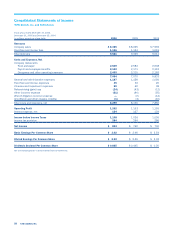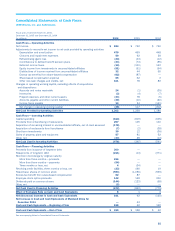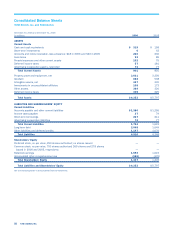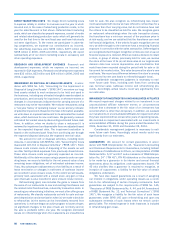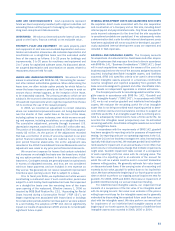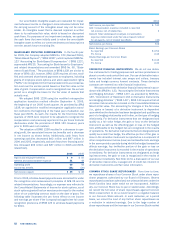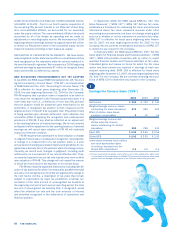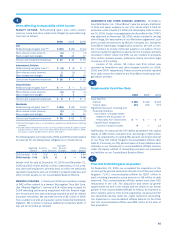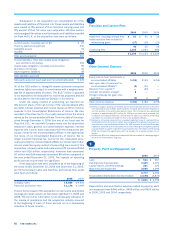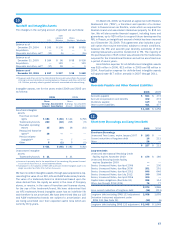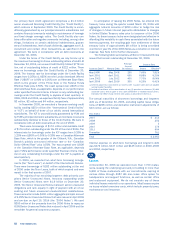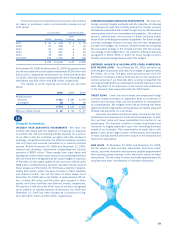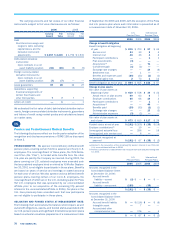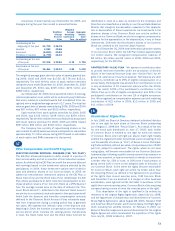Pizza Hut 2006 Annual Report Download - page 59
Download and view the complete annual report
Please find page 59 of the 2006 Pizza Hut annual report below. You can navigate through the pages in the report by either clicking on the pages listed below, or by using the keyword search tool below to find specific information within the annual report.
64 YUM! BRANDS, INC.
LEASE ACCOUNTING BY OUR PIZZA HUT UNITED KINGDOM UNCON-
SOLIDATED AFFILIATE Prior to our fourth quarter acquisition of
the remaining fifty percent interest in our Pizza Hut United King-
dom unconsolidated affiliate, we accounted for our ownership
under the equity method. The unconsolidated affiliate historically
accounted for all of its leases as operating and we made no
adjustments in recording equity income. We decreased our 2006
beginning retained earnings balance by approximately $4 million
to reflect our fifty percent share of the cumulative equity income
impact of properly recording certain leases as capital.
RECOGNITION OF CERTAIN STATE TAX BENEFITS We have histori-
cally recognized certain state tax benefits on a cash basis as they
were recognized on the respective state tax returns instead of in
the year the benefit originated. We increased our 2006 beginning
retained earnings by approximately $7 million to recognize these
state tax benefits as deferred tax assets.
NEW ACCOUNTING PRONOUNCEMENTS NOT YET ADOPTED
In July 2006, the FASB issued FASB Interpretation No. 48, “Account-
ing for Uncertainty in Income Taxes” (“FIN 48”), an interpretation
of FASB Statement No. 109, “Accounting for Income Taxes.” FIN
48 is effective for fiscal years beginning after December 15,
2006, the year beginning December 31, 2006 for the Company.
FIN 48 requires that a position taken or expected to be taken in
a tax return be recognized in the financial statements when it is
more likely than not (i.e., a likelihood of more than fifty percent)
that the position would be sustained upon examination by tax
authorities. A recognized tax position is then measured at the
largest amount of benefit that is greater than fifty percent likely
of being realized upon ultimate settlement. Upon adoption, the
cumulative effect of applying the recognition and measurement
provisions of FIN 48, if any, shall be reflected as an adjustment
to the opening balance of retained earnings. We do not currently
anticipate that the adjustment to the opening balance of retained
earnings we will record upon adoption of FIN 48 will materially
impact our financial condition.
FIN 48 requires that subsequent to initial adoption a change
in judgment that results in subsequent recognition, derecognition
or change in a measurement of a tax position taken in a prior
annual period (including any related interest and penalties) be rec-
ognized as a discrete item in the period in which the change occurs.
Currently, we record such changes in judgment, including audit
settlements, as a component of our annual effective rate. Thus,
our reported quarterly income tax rate may become more volatile
upon adoption of FIN 48. This change will not impact the manner
in which we record income tax expense on an annual basis.
FIN 48 also requires expanded disclosures including identifi-
cation of tax positions for which it is reasonably possible that total
amounts of unrecognized tax benefits will significantly change in
the next twelve months, a description of tax years that remain
subject to examination by major tax jurisdiction, a tabular rec-
onciliation of the total amount of unrecognized tax benefits at
the beginning and end of each annual reporting period, the total
amount of unrecognized tax benefits that, if recognized, would
affect the effective tax rate and the total amounts of interest
and penalties recognized in the statements of operations and
financial position.
In September 2006, the FASB issued SFAS No. 157, “Fair
Value Measures” (“SFAS 157”). SFAS 157 defines fair value,
establishes a framework for measuring fair value and enhances
disclosures about fair value measures required under other
accounting pronouncements, but does not change existing guid-
ance as to whether or not an instrument is carried at fair value.
SFAS 157 is effective for fiscal years beginning after Novem-
ber 15, 2007, the year beginning December 30, 2007 for the
Company. We are currently reviewing the provisions of SFAS 157
to determine any impact for the Company.
In February 2007, the FASB issued SFAS No. 159 “The Fair
Value Option for Financial Assets and Financial Liabilities,” (“SFAS
159”). SFAS 159 provides companies with an option to report
selected financial assets and financial liabilities at fair value.
Unrealized gains and losses on items for which the fair value
option has been elected are reported in earnings at each sub-
sequent reporting date. SFAS 159 is effective for fiscal years
beginning after November 15, 2007, the year beginning December
30, 2007 for the Company. We are currently reviewing the provi-
sions of SFAS 159 to determine any impact for the Company.
3.
Earnings Per Common Share (“EPS”)
2006 2005 2004
Net income $ 824 $ 762 $ 740
Weighted-average common shares
outstanding (for basic calculation) 273 286 291
Effect of dilutive share-based
employee compensation 9 12 14
Weighted-average common and
dilutive potential common
shares outstanding (for diluted
calculation) 282 298 305
Basic EPS $ 3.02 $ 2.66 $ 2.54
Diluted EPS $ 2.92 $ 2.55 $ 2.42
Unexercised employee stock options
and stock appreciation rights
(in millions) excluded from the
diluted EPS computation(a) 0.1 0.5 0.4
(a) These unexercised employee stock options and stock appreciation rights were
not included in the computation of diluted EPS because their exercise prices were
greater than the average market price of our Common Stock during the year.


